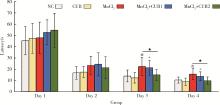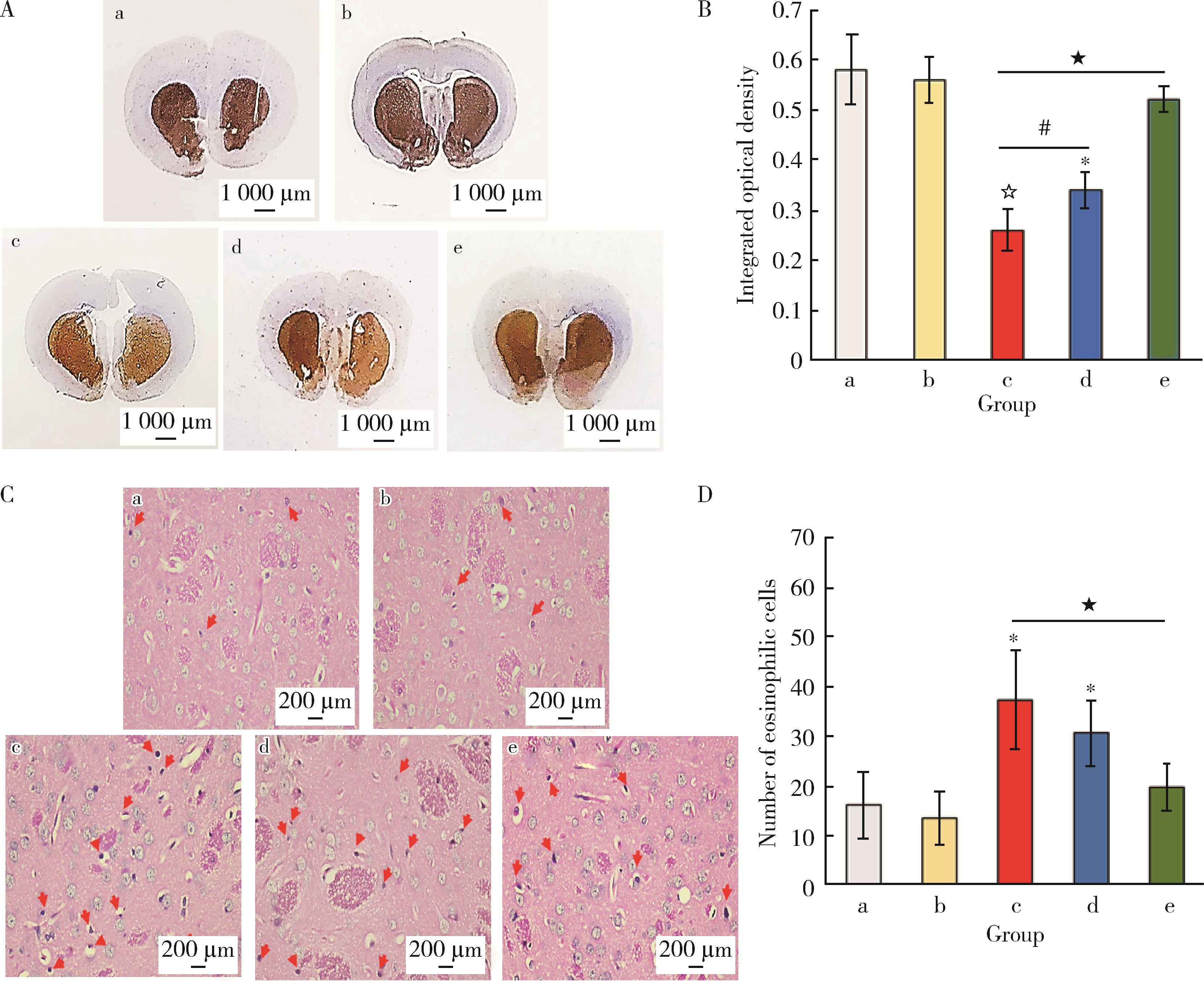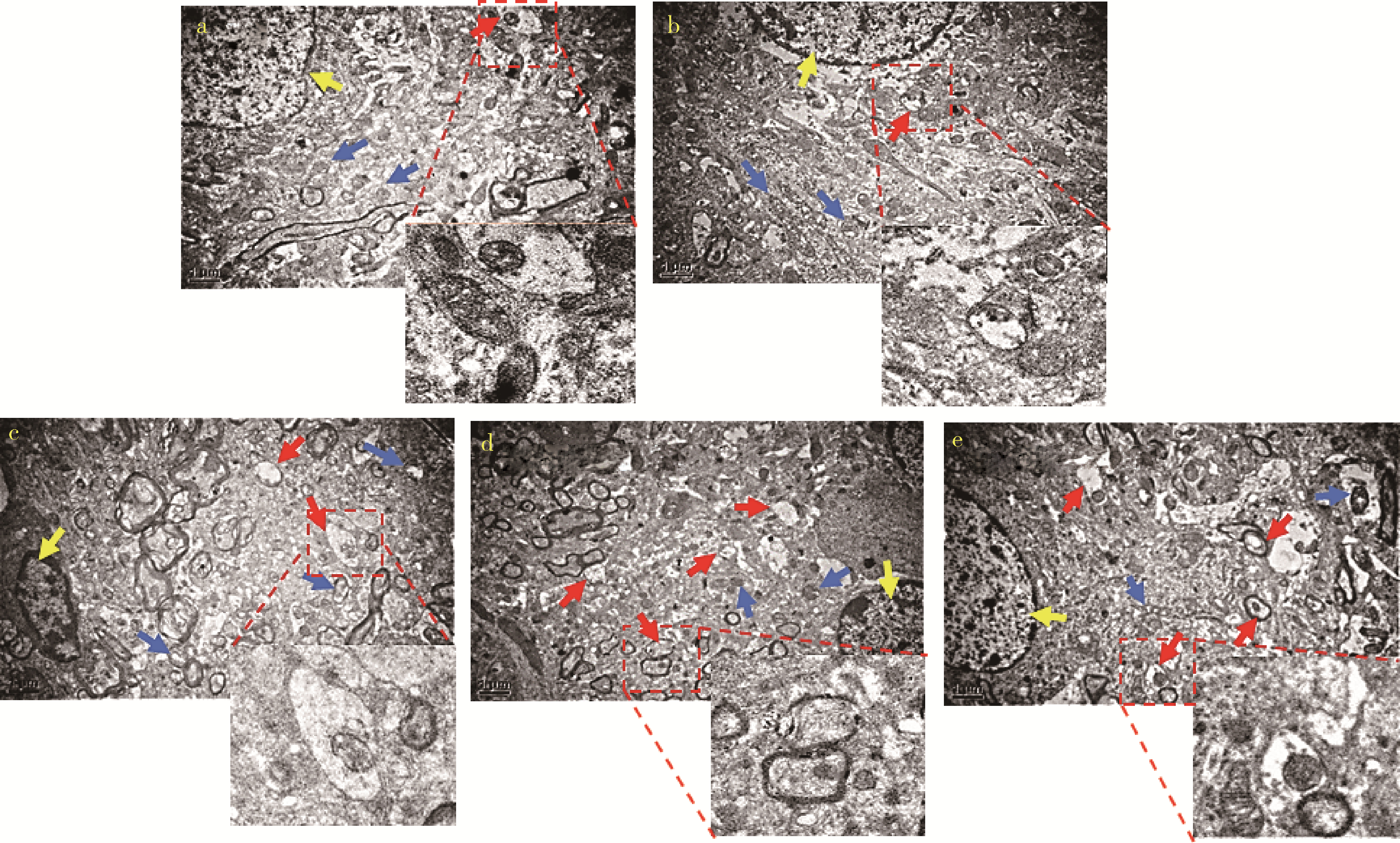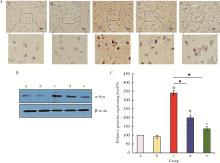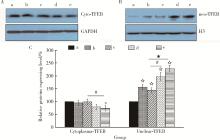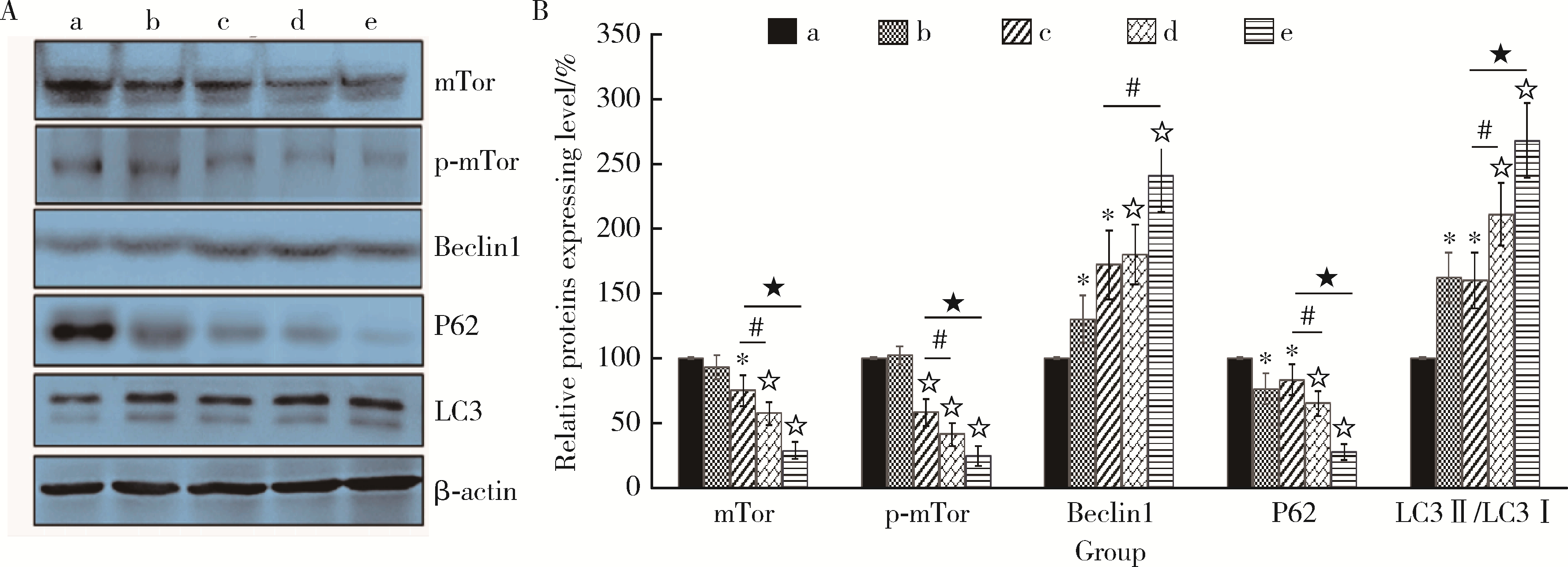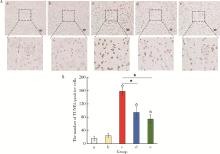Journal of Peking University (Health Sciences) ›› 2022, Vol. 54 ›› Issue (3): 400-411. doi: 10.19723/j.issn.1671-167X.2022.03.003
Previous Articles Next Articles
Curcumin alleviates the manganese-induced neurotoxicity by promoting autophagy in rat models of manganism
Li-ye LAI,Chang-song DOU,Cui-na ZHI,Jie CHEN,Xue MA,Peng ZHAO,Bi-yun YAO*( )
)
- Department of Toxicology, Peking University School of Public Health, Beijing Key Laboratory of Toxicological Research and Risk Assessment for Food Safety, Beijing 100191, China
CLC Number:
- R135.1
| 1 | Tarale P, Chakrabarti T, Sivanesan S, et al. Potential role of epigenetic mechanism in manganese induced neurotoxicity[J/OL]. Biomed Res Int, 2016, 2016: 1-18(2016-05-26)[2022-02-01]. http://dx.doi.org/10.1155/2016/2548792. |
| 2 | Yu Q , Zhou YZ . High level of Mn in brain is a risk for Alzheimer disease[J]. Acta Physiologica Sinica, 2018, 70 (2): 193- 200. |
| 3 |
Michalke B , Fernsebner K . New insights into manganese toxicity and speciation[J]. J Trace Elem Med Biol, 2014, 28 (2): 106- 116.
doi: 10.1016/j.jtemb.2013.08.005 |
| 4 | 滕小华, 刘宇昊, 李克非, 等. 环境锰污染对生物健康的威胁[J]. 东北农业大学学报, 2021, 52 (1): 90- 96. |
| 5 |
Perl DP , Olanow CW . The neuropathology of manganese-induced Parkinsonism[J]. J Neuropathol Exp Neurol, 2007, 66 (8): 675- 682.
doi: 10.1097/nen.0b013e31812503cf |
| 6 |
窦长松, 智翠娜, 刘文丽, 等. 锰中毒和PD模型小鼠神经行为改变及损伤部位的比较研究[J]. 中华劳动卫生职业病杂志, 2018, 36 (2): 84- 90.
doi: 10.3760/cma.j.issn.1001-9391.2018.02.002 |
| 7 | 刘文丽, 窦长松, 王裕, 等. MnCl2和MPP+诱导SK-N-SH细胞氧化应激及自噬的比较[J]. 中华劳动卫生职业病杂志, 2017, 35 (2): 78- 82. |
| 8 |
Zhang HT , Mi L , Wang T , et al. PINK1/Parkin-mediated mitophagy play a protective role in manganese induced apoptosis in SH-SY5Y cells[J]. Toxicol In Vitro, 2016, 34, 212- 219.
doi: 10.1016/j.tiv.2016.04.006 |
| 9 |
Wang T , Li X , Yang D , et al. ER stress and ER stress-mediated apoptosis are involved in manganese-inducedneurotoxicity in the rat striatum in vivo[J]. Neurotoxicology, 2015, 48, 109- 119.
doi: 10.1016/j.neuro.2015.02.007 |
| 10 |
Settembre C , Zoncu R , Medina DL , et al. A lysosometo-nucleus signalling mechanism senses and regulates the lysosome via mTOR and TFEB[J]. EMBO J, 2012, 31 (5): 1095- 1108.
doi: 10.1038/emboj.2012.32 |
| 11 |
Sardiello M , Palmieri M , di Ronza A , et al. A gene network regulating lysosomal biogenesis and function[J]. Science, 2009, 325 (5939): 473- 477.
doi: 10.1126/science.1174447 |
| 12 |
Settembre C , Di Malta C , Polito VA , et al. TFEB links autophagy to lysosomal biogenesis[J]. Science, 2011, 332 (6036): 1429- 1433.
doi: 10.1126/science.1204592 |
| 13 |
Jaroonwitchawan T , Chaicharoenaudomrung N , Namkaew J , et al. Curcumin attenuates paraquat-induced cell death in human neuroblastoma cells through modulating oxidative stress and autophagy[J]. Neurosci Lett, 2017, 636, 40- 47.
doi: 10.1016/j.neulet.2016.10.050 |
| 14 |
Defazio R , Criado A , Zantedeschi V , et al. Neuroanatomy-based matrix-guided trimming protocol for the rat brain[J]. Toxicol Pathol, 2015, 43 (2): 249- 256.
doi: 10.1177/0192623314538345 |
| 15 |
Forouzanfar F , Read MI , Barreto GE , et al. Neuroprotective effects of curcumin through autophagy modulation[J]. IUBMB Life, 2020, 72 (4): 652- 664.
doi: 10.1002/iub.2209 |
| 16 |
Yi LT , Dong SQ , Wang SS , et al. Curcumin attenuates cognitive impairment by enhancing autophagy in chemotherapy[J]. Neurobiol Dis, 2020, 136, 104715.
doi: 10.1016/j.nbd.2019.104715 |
| 17 |
Ji HF , Shen L . The multiple pharmaceutical potential of curcumin in Parkinson's disease[J]. CNS Neurol Disord Drug Targets, 2014, 13 (2): 369- 373.
doi: 10.2174/18715273113129990077 |
| 18 |
Sharma N , Nehru B . Curcumin affords neuroprotection and inhibits α-Synuclein aggregation in lipopolysaccharide-induced Parkinson's disease model[J]. Inflammopharmacology, 2018, 26 (2): 349- 360.
doi: 10.1007/s10787-017-0402-8 |
| 19 |
Shen JD , Wei Y , Li YJ , et al. Curcumin reverses the depressive-like behavior and insulin resistance induced by chronic mild stress[J]. Metab Brain Dis, 2017, 32 (4): 1163- 1172.
doi: 10.1007/s11011-017-0017-1 |
| 20 | Liao D, Lv C, Cao L, et al. Curcumin attenuates chronic unpredictable mild stress-induced depressive-like behaviors via restoring changes in oxidative stress and the activation of Nrf2 signaling pathway in rats[J/OL]. Oxid Med Cell Longev, 2020, 2020: 1-11(2020-09-18)[2022-02-05]. https://doi.org/10.1155/2020/9268083. |
| 21 |
Mansouri Z , Sabetkasaei M , Moradi F , et al. Curcumin has neuroprotection effect on homocysteine rat model of Parkinson[J]. J Mol Neurosci, 2012, 47 (2): 234- 242.
doi: 10.1007/s12031-012-9727-3 |
| 22 | Maiti P , Dunbar GL . Use of curcumin, a natural polyphenol for targeting molecular pathways in treating age-related neurodegenerative diseases[J]. Int J Mol Sci, 2018, 19 (6): 16378. |
| 23 |
ELBini-Dhouib I , Doghri R , Ellefi A , et al. Curcumin attenuated neurotoxicity in sporadic animal model of Alzheimer's disease[J]. Molecules, 2021, 26 (10): 3011.
doi: 10.3390/molecules26103011 |
| 24 |
Verina T , Schneider JS , Guilarte TR . Manganese exposure induces α-synuclein aggregation in the frontal cortex of non-human primates[J]. Toxicol Lett, 2013, 217 (3): 177- 183.
doi: 10.1016/j.toxlet.2012.12.006 |
| 25 | 吴忧, 徐彬, 梁顺利, 等. 姜黄素对帕金森病小鼠运动障碍和多巴胺能神经元存活的影响及机制研究[J]. 中国中西医结合杂志, 2018, 38 (7): 838- 843. |
| 26 |
Singh PK , Kotia V , Ghosh D , et al. Curcumin modulates alpha-synuclein aggregation and toxicity[J]. ACS Chem Neurosci, 2013, 4 (3): 393- 407.
doi: 10.1021/cn3001203 |
| 27 |
Yu L , Chen Y , Tooze SA . Autophagy pathway: Cellular and molecular mechanisms[J]. Autophagy, 2018, 14 (2): 207- 215.
doi: 10.1080/15548627.2017.1378838 |
| 28 |
Satoo K , Noda NN , Kumeta H , et al. The structure of Atg4B-LC3 complex reveals the mechanism of LC3 processing and delipidation during autophagy[J]. EMBO J, 2009, 28 (9): 1341- 1350.
doi: 10.1038/emboj.2009.80 |
| 29 |
Zaffagnini G , Savova A , Danieli A , et al. Phasing out the bad-how SQSTM1/p62 sequesters ubiquitinated proteins for degradation by autophagy[J]. Autophagy, 2018, 14 (7): 1280- 1282.
doi: 10.1080/15548627.2018.1462079 |
| 30 |
Yoshii SR , Mizushima N . Monitoring and measuring autophagy[J]. Int J Mol Sci, 2017, 18 (9): 1865.
doi: 10.3390/ijms18091865 |
| 31 |
Zhang J , Cao R , Cai T , et al. The role of autophagy dysregulation in manganese-induced dopaminergic neurodegeneration[J]. Neurotox Res, 2013, 24 (4): 478- 490.
doi: 10.1007/s12640-013-9392-5 |
| 32 |
Limanaqi F , Biagioni F , Busceti CL , et al. Phytochemicals bridging autophagy induction and alpha-synuclein degradation in Parkinsonism[J]. Int J Mol Sci, 2019, 20 (13): 3274.
doi: 10.3390/ijms20133274 |
| [1] | Fan ZHANG,Tai-qiang YAN,Wei GUO. Rasfonin inhibits proliferation and migration of osteosarcoma 143B cells [J]. Journal of Peking University(Health Sciences), 2019, 51(2): 234-238. |
| [2] | SUN Jing, SONG Wei-dong, YAN Si-yuan, XI Zhi-jun. Chloroquine inhibits viability of renal carcinoma cells and enhances sunitinib-induced caspase-dependent apoptosis [J]. Journal of Peking University(Health Sciences), 2018, 50(5): 778-784. |
| [3] | CAO Pei, JIANG Xue-jun, XI Zhi-jun. Sunitinib induces autophagy via suppressing Akt/mTOR pathway in renal cell carcinoma [J]. Journal of Peking University(Health Sciences), 2016, 48(4): 584-589. |
|
||
